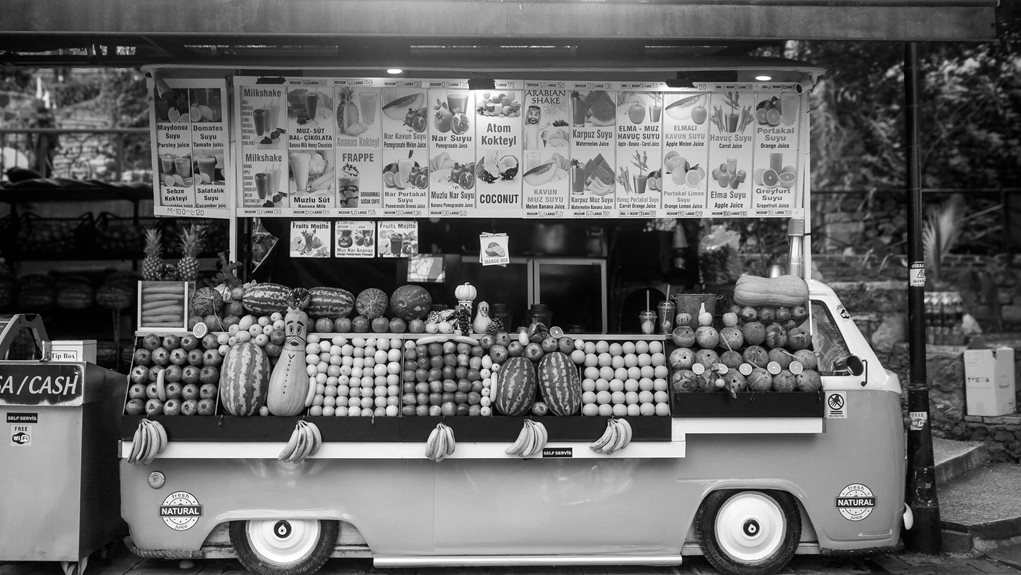To juice a pineapple, start by selecting a ripe one that’s yellow with green hints and has a sweet aroma from the base. Cut off both ends, slice it lengthwise, and remove the core and skin, cutting the flesh into chunks that’ll fit your juicing method. Use either an electric juicer for efficiency or blend and strain through cheesecloth for about 800ml of fresh juice. For the best results and longest shelf life, there’s more to contemplate about proper straining and storage techniques.
Prepare and Cut Your Fresh Pineapple
Four key steps are essential when preparing a fresh pineapple for juicing. Start by selecting a ripe pineapple that’s yellow with green hints, feels heavy, and emits a sweet aroma from its base. The leaves should be vibrant and easily pluckable.
Next, trim both ends and slice the pineapple lengthwise down the middle. Stand it upright on the cut end for stability during cutting. For optimal freshness, you can store cut pieces in an airtight container in the refrigerator for up to three days.
Then, remove the core by cutting a V-shape inward, and peel the outer skin in strips. Don’t forget to remove any remaining eyes with a paring knife.
Finally, cut your pineapple into pieces that’ll fit your juicer chute. Make slices 1⁄4 to 1⁄2 inch thick to break up the fibers, and cube the core. This preparation guarantees ideal juicing results.
Choose Your Juicing Method and Equipment
Three main methods exist for extracting fresh pineapple juice: using an electric juicer, blending and straining, or employing manual tools. Your choice depends on your desired production scale and available equipment.
An electric juicer offers the most efficient option, featuring a screw-type mechanism that separates juice from pulp automatically. For industrial applications, specialized machines with screw extractors provide high-efficiency juice extraction. You’ll get about 700ml of juice per pineapple with minimal effort.
If you don’t have a juicer, use your blender or food processor, then strain the puree through a mesh strainer or cheesecloth. This method yields slightly more juice (800ml) but requires extra work.
For small batches, a manual juicer works fine, though it demands more physical effort.
Industrial machinery becomes necessary only if you’re processing pineapples on a commercial scale.
Strain, Serve and Store Your Pineapple Juice
Successfully straining, serving, and storing your pineapple juice requires careful attention to several key steps.
Start by straining your juice through a fine mesh strainer or cheesecloth-lined colander immediately after blending. Press firmly to extract maximum juice, and strain multiple times if you want clearer results. Natural sugars present in pineapple juice make it crucial to maintain proper refrigeration temperatures.
Serve your juice right away for the best flavor, adding ice if you’d like it colder. You can enhance it with garnishes like mint or lemon, and adjust the consistency with water to your preference.
To store properly, transfer your juice to an airtight container within two hours and keep it below 39°F in your refrigerator. It’ll last 5-7 days when stored correctly.
Watch for signs of spoilage like mold, brown coloring, or off-putting odors, and discard if you notice any of these changes.



Konnichiwa! (Hello!) I'm Pat Tokuyama, a Japanese tofu cookbook author, who travels for music, food, and adventure. If you like Japanese tea, checkout some of the newestorganic japanese tea, matcha bowls and noren and more!
** Curious about the Plant Based Japanese Cooking Club? ** Learn more here!